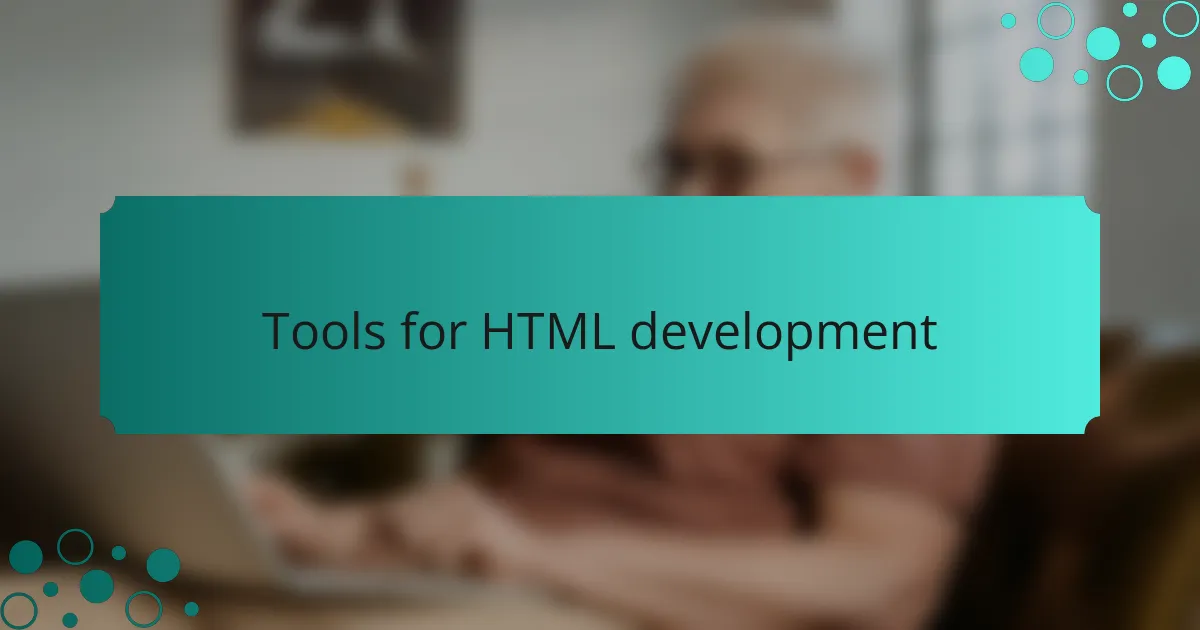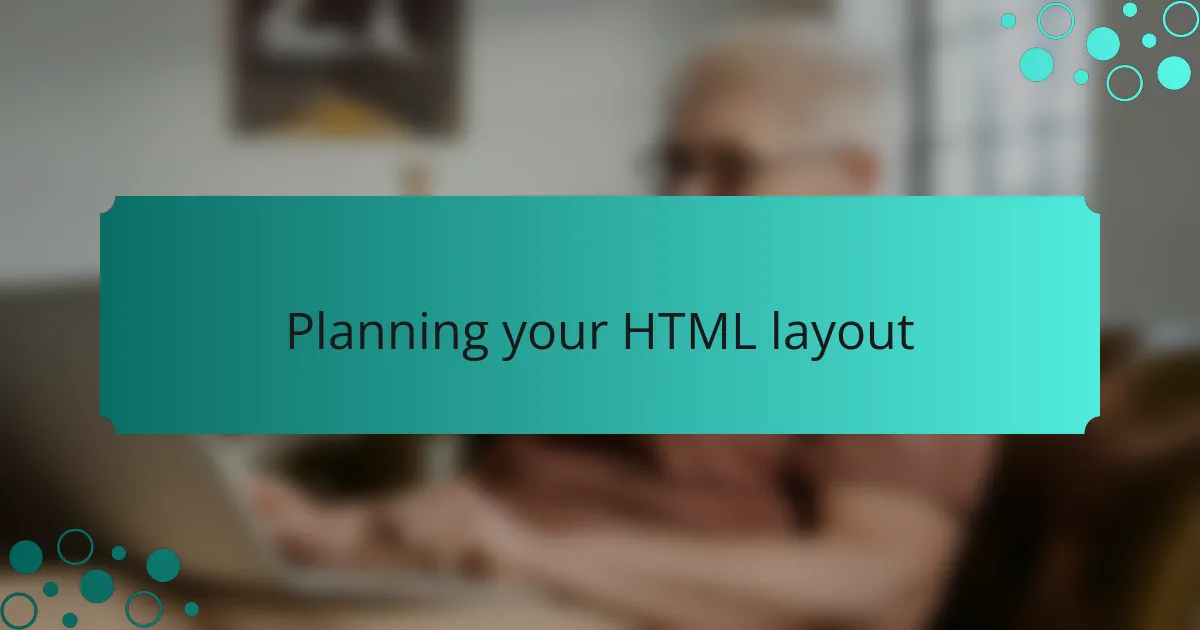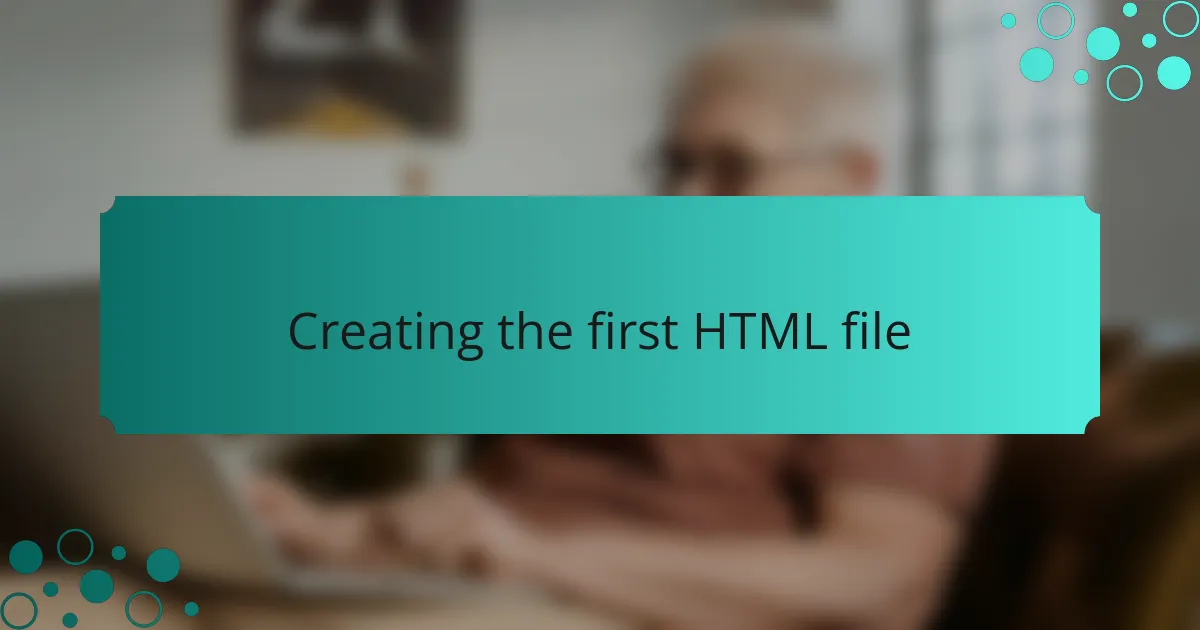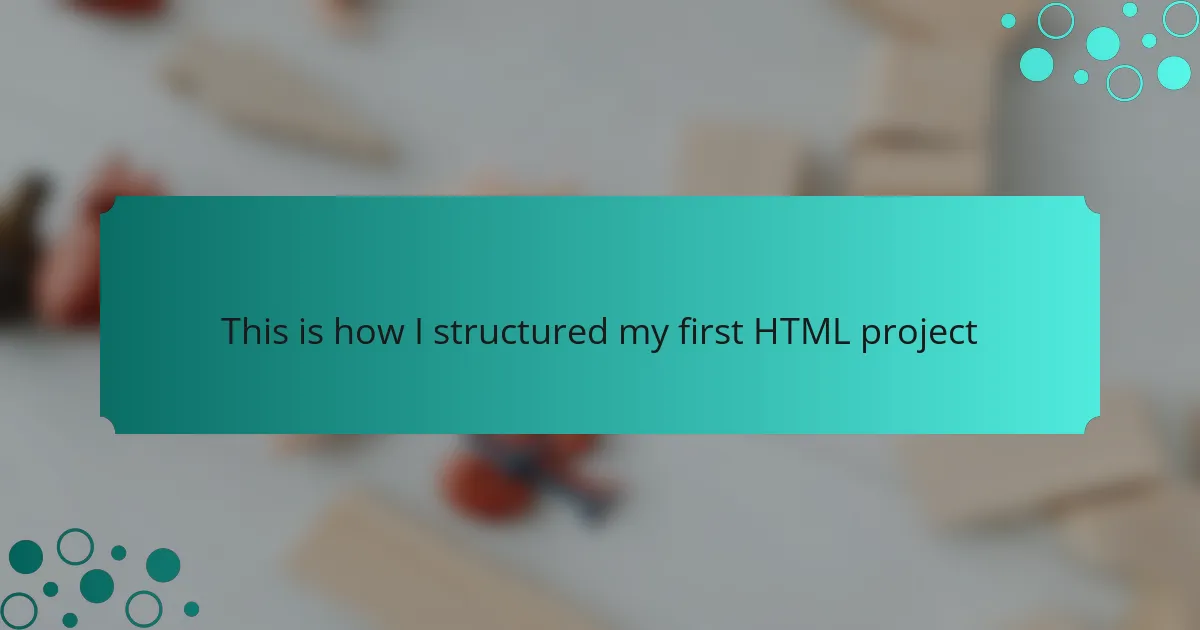Key takeaways
- Understanding project structure is essential for smooth HTML development, improving efficiency and collaboration.
- Choosing the right development tools, such as specialized code editors, can enhance your coding experience.
- Planning your HTML layout with key elements in mind—like header, navigation, and footer—helps organize thoughts and simplify coding.
- Keeping code clean and organized, along with breaking tasks into manageable pieces, boosts confidence and learning in beginners.

Introduction to HTML projects
Starting your first HTML project can be an exciting journey. I still remember the thrill of creating my first simple webpage. The possibilities felt endless, and that initial sense of achievement is something I cherish.
HTML, or Hypertext Markup Language, serves as the foundation for all web development. It’s not just about coding; it’s about bringing ideas to life on a screen. Have you ever thought about how a single webpage is built? Each element, from headings to images, plays a vital role in crafting the user experience.
As I dove into my first project, I learned the value of structure and organization. I started by sketching out my ideas on paper, thinking about what I wanted to communicate. This preparation made the actual coding process smoother and more enjoyable. How do you approach your planning phase? I find that taking time to visualize your end goal can make all the difference when you start writing your HTML.

Understanding project structure
Understanding project structure is crucial for any web development novice, and it was a lesson I learned firsthand when I started my first HTML project. Initially, I underestimated the importance of a well-organized file structure. But, after facing issues locating my images and stylesheets, I realized that a clear organization not only keeps your project tidy but also saves a lot of time during development.
In my experience, creating designated folders for assets like images, CSS, and JavaScript transformed my workflow. I remember the moment of relief when everything was neatly stored; it felt like I could finally focus on crafting the content instead of digging through chaotic files.
Here’s a simple comparison of project structure versus disorganization:
| Project Structure | No Project Structure |
|---|---|
| Clear organization of files | Chaotic and hard to find files |
| Improved workflow efficiency | Time wasted searching for resources |
| Enhanced collaboration with others | Difficulties when sharing code |

Tools for HTML development
When I first began my journey into HTML development, I discovered that the right tools can make all the difference. I started with simple text editors like Notepad, but soon realized that specialized code editors offered features like syntax highlighting and error detection, which significantly improved my workflow.
I remember the excitement of trying out different integrated development environments (IDEs). Each one had its unique set of features and quirks that influenced my coding style. Over time, I found a few tools that truly resonate with my needs, making coding not just easier but more enjoyable.
Here’s a quick comparison of some popular tools that I believe can help you on your HTML development journey:
“`html
| Tool | Features |
|---|---|
| Notepad | Basic text editing, no syntax highlighting |
| Visual Studio Code | Intelligent code completion, extensions available |
| Sublime Text | Fast and responsive, customizable interface |
| Atom | Open-source, extensive package library |
“`
These tools each have their strengths, and choosing the right one can enhance your coding experience significantly. What are your favorite tools?

Planning your HTML layout
When I started my first HTML project, planning the layout felt a bit overwhelming, but it turned out to be my favorite phase. I remember sketching my ideas on paper, working through how I wanted each section to flow and interact. This visual approach not only helped me organize my thoughts but also ignited my creativity and enthusiasm for the project.
Taking the time to outline your layout can significantly guide your coding process. Here’s a quick list of elements to consider when planning your HTML structure:
- Header: Where your site title or logo will go.
- Navigation: Menus or links to other pages.
- Main Content: The focal point of your website, like articles or images.
- Sidebar: Additional content such as links or ads (if applicable).
- Footer: Contact information, copyright notice, or links to privacy policies.
By breaking it down like this, I found it easier to visualize how everything would work together. Trust me, investing a little time in planning can pay off immensely later on.

Creating the first HTML file
When I started my first HTML project, creating the initial HTML file was exciting yet overwhelming. I remember staring at my text editor, wondering if I was doing it right. The simplicity of a single file structure, with just a few essential tags, made me feel like I was building something from scratch.
In my personal experience, starting with a basic template helped me tremendously. I laid out a structure that included the document type, the HTML element itself, a head element for metadata, and the body where all my content would go. It felt like opening a door to endless possibilities!
Here’s a quick comparison table showcasing the essential elements of an HTML file versus more advanced project structures. This helped clarify the components during my learning process.
| Element | Purpose |
|---|---|
| DOCTYPE | Defines the document type and version of HTML |
| HTML | The root element that wraps all content |
| HEAD | Contains meta-information about the document |
| BODY | Holds the content displayed in the browser |

Personal tips for beginners
When I started my first HTML project, I quickly realized the importance of breaking down tasks into manageable pieces. It felt overwhelming at first, but focusing on one small section at a time really helped me gain confidence. I remember spending hours perfecting a simple navigation bar, and the satisfaction I felt when it finally worked was priceless.
One key aspect that helped me was keeping my code clean and organized. I learned to comment on my code as I went along, which not only made it easier to revisit later but also provided significant clarity to my thought process. Here are some tips I found invaluable during my journey:
- Start with a clear plan: Sketch out a rough layout of your project before diving into coding.
- Use descriptive filenames: It helps you remember what each file is for.
- Validate your HTML: Tools like the W3C validator can catch errors early.
- Experiment and play: Don’t be afraid to try new things; it’s how you learn!
- Seek feedback: Share your progress with friends or online communities; their insights can provide fresh perspectives.
